
At Kumbum monastery regular police in green and People’s Armed Police in black prepare for the festival.
- Thousands of Tibetans gathered in the last few days of Tibetan New Year (Losar) for significant religious ceremonies in eastern Tibet, despite being forced to confront massed ranks of armed troops. Vivid images disseminated on social media show higher numbers of Tibetans than usual gathering to pray at major monasteries – Labrang and Kumbum – during the Monlam prayer festival as troops stand guard or encircle the pilgrims. The new pictures emerged days in the tense buildup to March 10, the sensitive 54th anniversary of Tibet’s national uprising and the fifth anniversary of an unprecedented wave of mostly peaceful protests that swept across the Tibetan plateau in 2008.
- The Tibetans gathered in areas where a number of self-immolations have occurred over the past six months, including Labrang in Gansu and Rebkong in Qinghai. The most recent self-immolations by Tibetans occurred at monasteries in eastern Tibet during religious ceremonies, and harrowing images have emerged of pilgrims witnessing the death of Tsesung Kyab (ICT report, Two Tibetans self-immolate at monasteries during prayer ceremonies in Amdo). The images emerged despite the high risk for Tibetans of sharing photographs; this can be penalized by torture or imprisonment as part of China’s attempts to prevent any information or pictures from Tibet reaching the outside world.
- The peaceful gatherings for Monlam Chenmo are a compelling testimony to Tibetan resilience and determination to express their religious identity even in the face of an intimidating security presence in the form of Chinese police and units of the People’s Armed Police, some outfitted in body armor and helmets. A former monk from Labrang monastery who now lives in exile told ICT: “What is most striking about these images is both the number of pilgrims, and the strong presence of Chinese soldiers. Normally you would not see such a strong military presence at a prayer ceremony. This shows the fears of the authorities about the self-immolations and protests. The number of pilgrims shows how determined people are to pray and make offerings at such a dangerous time in Tibet.”
The heightened security presence visible in the pictures is indicative of China’s more systematic and aggressive response to the Tibetan self-immolations, a response that ignores the root causes of the self-immolations and, since the end of 2012, has included the criminalization of the self-immolations and retributive actions against families, relatives, or monasteries associated with Tibetans who have self-immolated.
Other images also disseminated on Tibetan social media sites from Amdo show Tibetan students and writers gathered to recite poetry and sing in front of an image of the Dalai Lama on International Mother Language Day, a UN-recognized observance held annually on 21 February worldwide. This strong display of Tibetan linguistic and religious identity took place in front of an audience of local Tibetans in spite of warnings from the authorities.
Thousands converge upon Labrang Tashikyil
The new images from Labrang (Chinese: Xiahe) depict Tibetans gathering for the important Monlam ceremony on February 22, which begins on the third day of Losar. According to some reports, as many 30,000 people converged upon Labrang Tashikyil monastery, which is one of the great monasteries in the Gelugpa tradition and one of the most important centers of Tibetan religious culture in Tibet.
The Monlam prayer ceremony was founded by Tsongkhapa, the religious teacher and founder of the Gelugpa school of Tibetan Buddhism to which the Dalai Lama adheres. The large gathering of pilgrims is likely to be an indicator of the intense devotion to their religious leader that the Chinese authorities have sought to suppress as well as a reflection of Tibetan determination to express their religious identity. It is notable, given their numbers, that not a single policeman is visible in any of the pictures used in article report by the state media about the festival. (Xinhua, Lamas attend Buddhist ritual in Gansu – February 23)
The most recent self-immolation in Labrang was on February 17, during the 15-day Losar period; distressing images emerged of a 49-year old Tibetan man called Namlha Tsering on fire in the main street of Labrang, Gansu (the Tibetan area of Amdo), which is not far from Labrang monastery. A Tibetan man in his sixties called Dhondup set himself ablaze and died outside the monastery on October 22, 2012. (ICT report, Self-immolation at Tibet’s Labrang monastery).
In Tibetan culture, when a person dies the body has to be left undisturbed while special prayers and ceremonies are held for the transference of the person’s consciousness on the path to a beneficial rebirth. This is one of the reasons why in a number of cases, Tibetans at the scene of a self-immolation have risked their lives in attempts to protect the body of the person who has set fire to themselves, and to take them to a place of safety – either a monastery or the person’s home – where traditional rituals can be carried out. It compounds the agony for Tibetans when monks are blocked from praying for Tibetans who have died, as they have been in Labrang and other areas. In a remarkable set of images, armed paramilitary troops are seen converging upon the body of Dorje Rinchen, who self- immolated in Labrang on October 23, 2012, while local people try to protect him, wreathed in smoke from his burning body. Further images obtained from Labrang that day depict streams of monks and laypeople walking to his home to carry out the traditional rituals, after Chinese police failed to take away his body. (ICT report, New images from Tibet depict self-immolation of Dorje Rinchen in Labrang today and aftermath).
From 2009 onwards, Tibetans have generally observed the Losar period in somber reflection on the crackdown following the protests that swept across Tibet in March and April, 2008, and the wave of self-immolations that began in February, 2009. In marking the shift away from traditional celebration, Tibetan writer Woeser, who lives in Beijing, wrote in January, 2009:
“This year’s differences are due to the fact that so many people have been plunged into the abyss of misery. In the land of Tibet, in the villages, pastures and towns of Amdo, central Tibet and Kham, many white-haired grandparents and parents had to endure the suffering of attending the funeral of young black-haired people. What is even more tragic is that some of these white-haired ones have not been able to attend the funeral services since the black-haired ones have disappeared without their corpses being able to be found. The family members do not know the day they died, thus, it is not even possible to hold the religious ceremony to release the soul of the deceased from purgatory suffering. The monasteries have already been closed, and monks expelled. There are countless vultures circling over the desolate sky burial grounds.” (Woeser blog posting, January 8, 2009, translated by High Peaks Pure Earth).
Tibetans mark Monlam Chenmo at Kumbum
Thousands of Tibetans also converged upon another of the great Gelugpa monasteries, Kumbum in Qinghai (the Tibetan area of Amdo), south-west of the provincial capital of Xining, for the Monlam Chenmo ceremony.
A Tibetan in exile told ICT that according to a Tibetan who attended, at least 35,000 people went to the ceremony on February 24, and the military presence was much more intense than in previous years.
The Monlam Chenmo is an auspicious and significant festival, marked every year by ‘flower offerings’ and images of deities made with butter in different colours.
Images from Rebkong depict intense security as Tibetans gather
During the same festival in Rebkong, where eight self-immolations have occurred over the past year, Tibetans who flocked to the main square in front of the monastery on February 24 were met by troops. According to Tibetan sources in exile, not only the main square, but the whole town of Rebkong (Chinese: Tongren) was under lockdown with tight security throughout. One Tibetan source said: “Firemen and trucks were stationed all over the town, and plain clothes police mingled with uniformed security personnel among the crowds. Surveillance within the monastery was also intensified.”
The same Tibetan sources said that many thousands of Tibetans marked the Monlam Chenmo festival in Rebkong, with laypeople joining monks for a special prayer ceremony.
The self-immolations of several Tibetans in Rebkong in November 2012 were followed by spontaneous gatherings of thousands of Tibetans to mark the deaths of the Tibetans who had set themselves on fire and in peaceful protest and vigils. All sectors of society – students, farmers, monks, nomads, teachers, children – came together to make reasonable and measured demands for change. Students at Qinghai Nationalities University held a vigil in solidarity with the self-immolators, and thousands of schoolchildren and students marched peacefully through Rebkong in Amdo, gathering later to chant long life prayers for the Dalai Lama. (ICT report, Storm in the Grasslands: Self-immolations in Tibet and Chinese Policy). There have been a number of other major, peaceful Tibetan demonstrations in the square since protests swept across Tibet in March-April 2008.
Tibetans assert their linguistic identity
In addition to the images of Tibetans gathered on International Mother Language Day in Chigdril county in Golog (Chinese: Guoluo) in Qinghai province (the Tibetan area of Amdo), the Tibetan service of Radio Free Asia reported that posters describing the Tibetan language as “the golden cup that holds the essence of Tibetan culture” had appeared in public places across Luchu (Chinese, Luqu) and Machu (Maqu) counties in Gannan Tibetan Autonomous Prefecture, Gansu province (Radio Free Asia, Push to preserve the Tibetan language in China – February 25).
Protection of language, a bedrock of culture, has reportedly inspired self-immolators in Amdo and Kham. A harrowing video online shows some of the last words of Ngawang Norphel, who self-immolated on June 20, 2012, in Tridu (Chinese: Chengduo) county, Yushu Tibetan Autonomous Prefecture, Qinghai province. The video depicts 22-year old Ngawang Norphel after his self-immolation lying on his side in Zilkar monastery with his disfigured face and head visible. Clearly in agonizing pain, Ngawang Norphel begins to talk about his concerns, with the Tibetan language mentioned first (The video can be viewed online on YouTube: Video footage of self-immolation in Tibet (subtitles)). Jamyang Palden, who self-immolated in Rebkong on March 14, 2012, called for protection of the Tibetan language as he set himself ablaze, while Lama Sobha, who died after his self-immolation in January, 2012, said in a tape he left behind: “The elders should carry out spiritual practice as well as maintain and protect Tibetan language and culture by using all your resources and by involving your body, speech and mind.”

* Please click image for a larger view
At Labrang monastery, one of the largest monasteries in Amdo, throngs of pilgrims wait for the unveiling of an enormous thangka on the festival day of Monlam. They are watched by a formation of People’s Armed Police which stretches along the entire length of the Sangchu River in town. On the right-hand side of this panoramic image the thangka can be seen in orange, carried upon the shoulders of Labrang monks.
The Monlam ceremony was established by Tsongkhapa, the founder of the Gelug school of Tibetan Buddhism. It is a very important holiday for local Tibetans, and pilgrims will come from across Tibet to see the unveiling of the thangka at Labrang. After a three-hour ceremony including prayers and offerings of khatas to the Buddha, the thangka is rolled up and put back inside the monastery. The number of pilgrims present this year seems to be higher than in previous years, as does the size of the police presence.
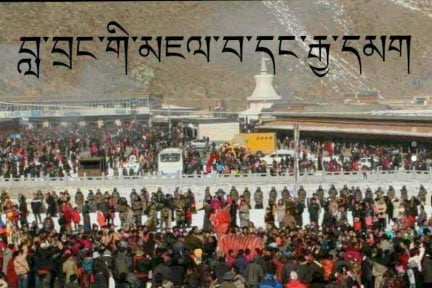
A closer view of Labrang monastery, circulated among Tibetan social media users, shows one segment of the police formation. The Tibetan-language caption reads “Labrang’s pilgrims and the Chinese army.”
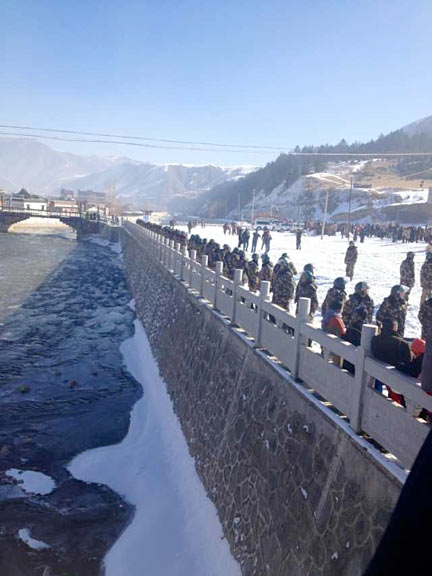
One of the police formations at Labrang, lined up along the Sangchu River.
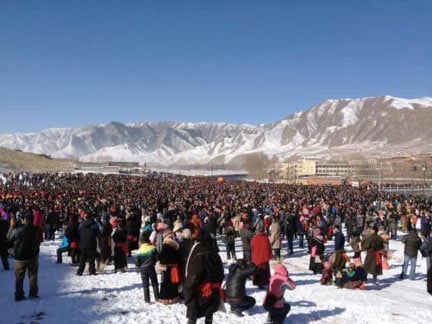
Tens of thousands of Tibetans gather near Labrang for the Goeku ceremony, in which the great thangka is unveiled.
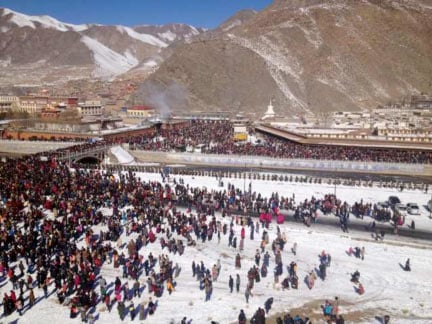
Pilgrims are seen crossing a bridge between Labrang (on the right) and a smaller Nyingma-school monastery (on the left) on their way to the site of the Goeku ceremony.
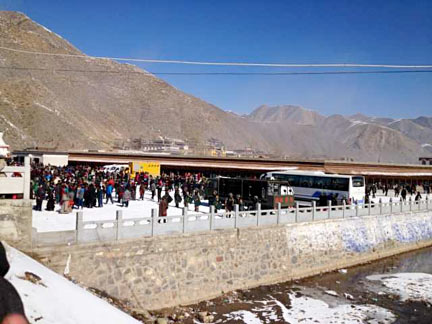
Police standing at attention next to a police vehicle parked near the covered kora route around Labrang monastery.
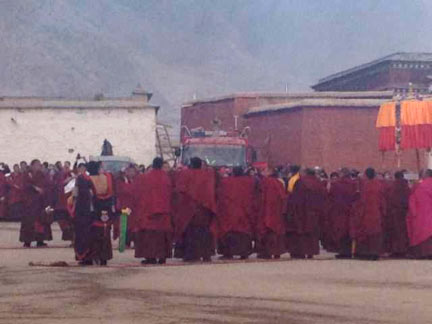
A fire engine stationed at Labrang monastery.
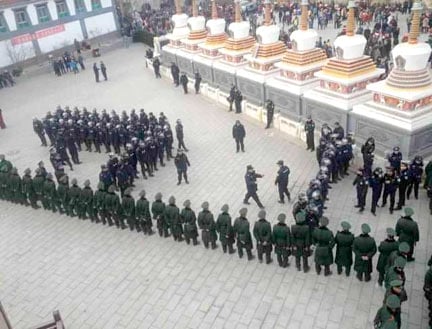
At Kumbum Monastery, traditionally one of the greatest Gelugpa monasteries, regular police in green and People’s Armed Police in black prepare for the beginning of the festival. The PAP wear body armor and helmets, and are armed with clubs and guns.
Kumbum was founded more than 400 years ago, near the site where Tsongkhapa was born in 1357. Although it was traditionally home to thousands of monks, Chinese policies have reduced that number to the low hundreds. Arjia Rinpoche, the abbot of Kumbum, fled Tibet in 1998 and has lived in the United States since then.
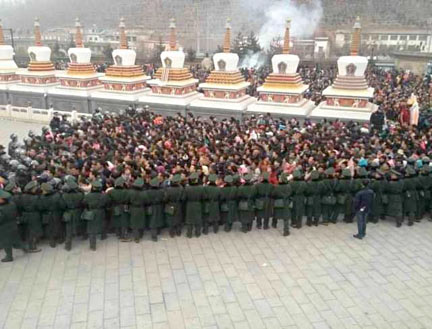
Tibetans surrounded by police as they enter Kumbum monastery.
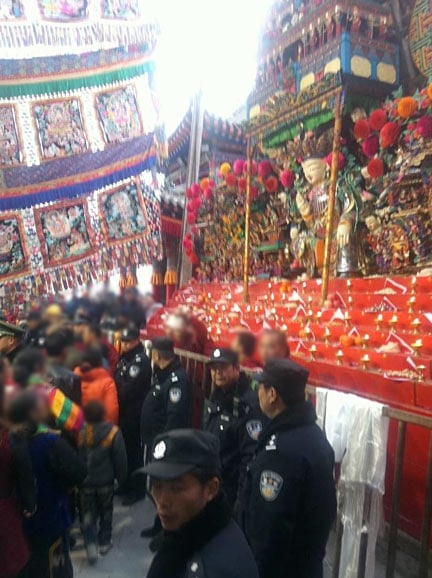
Police stand in front of an altar inside Kumbum monastery as pilgrims file past.
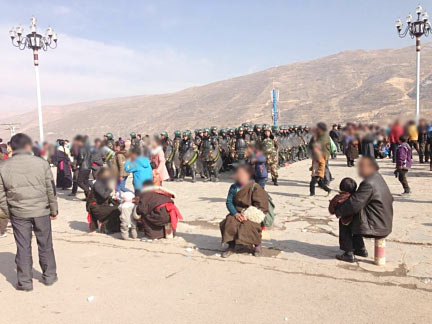
An intimidating police presence among Tibetan worshippers in Drolma Square, Rebkong (Chinese: Tongren), Qinghai province.
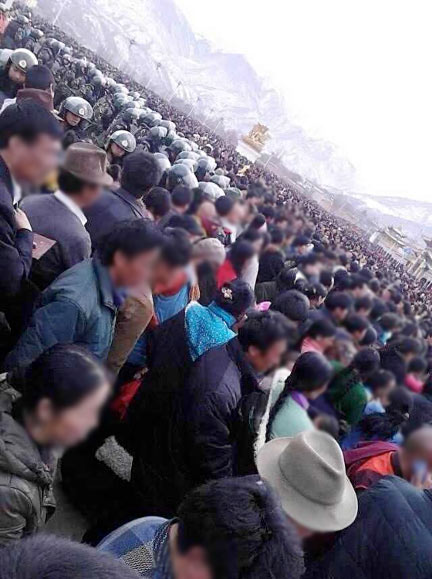
The People’s Armed Police (PAP), wearing green helmets with visors, among worshippers in Drolma Square, Rebkong.
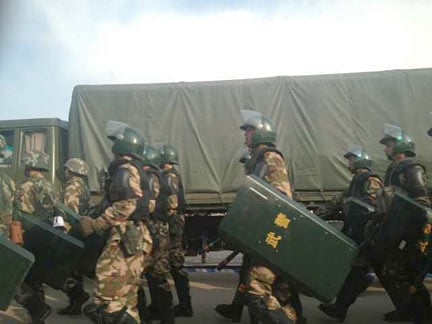
A squad of PAP march past a PAP truck in Rebkong.
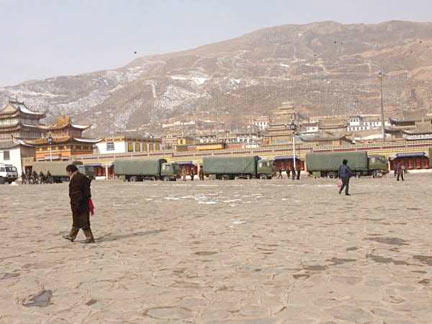
Green covered trucks, frequently used to transport large numbers of PAP, parked outside a monastery in Rebkong during Losar.
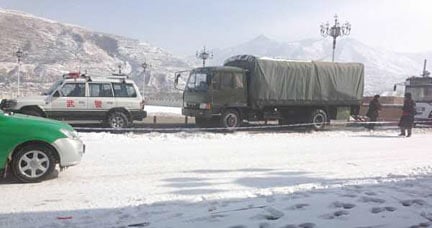
Green covered trucks, frequently used to transport large numbers of PAP, parked outside a monastery in Rebkong during Losar.
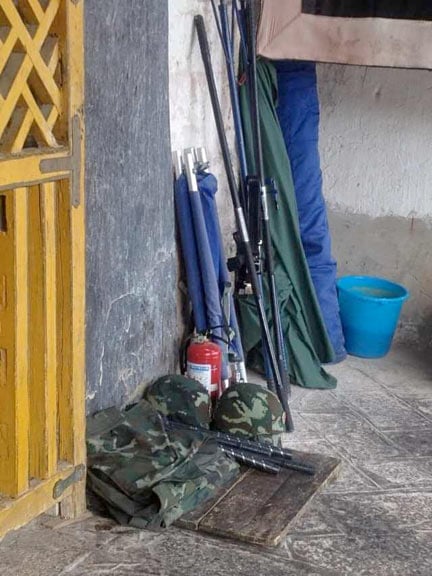
Tools of the trade: Spotted in Rebkong, police gear includes helmets, camouflaged body armor, clubs, a fire extinguisher, and poles. Although the intended use of these poles is unclear, specially-made poles designed to overpower self-immolators were spotted several times in August 2012 in Lhasa.
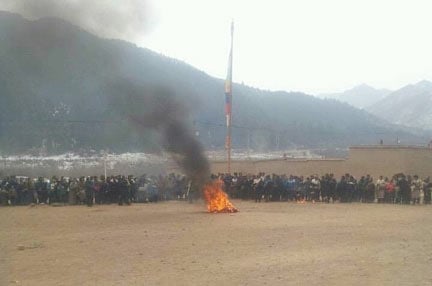
In Luchu, Amdo (Chinese: Luqu, Gansu province), a picture captures the self-immolation of Tsesung Kyab outside the main temple of Shitsang Gonsar monastery on February 25, 2013. A crowd of pilgrims bears witness to the event, despite the risk of being prosecuted later by Chinese authorities. Tsesung Kyab was the fifth Tibetan to self-immolate in Luchu.
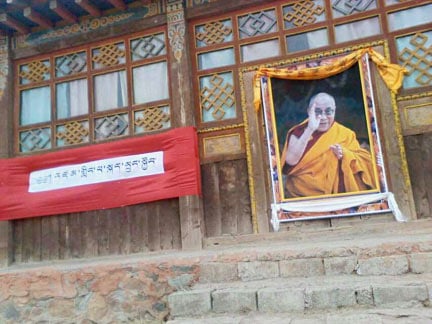
In Chigdril, Amdo, a portrait of the Dalai Lama is flanked by signs which wish for an auspicious International Mother Language Day. Public displays of images the Dalai Lama are typically not allowed by Chinese authorities, but Tibetans gathered nonetheless on February 21, 2013, to hear young students and writers wearing traditional Tibetan clothing recite poems and sing.
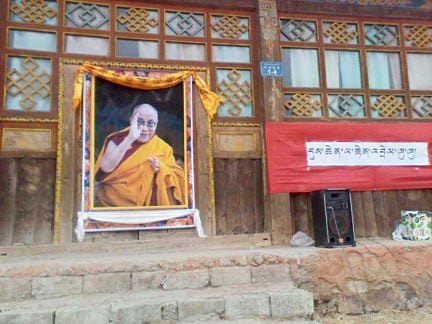
In Chigdril, Amdo, a portrait of the Dalai Lama is flanked by signs which wish for an auspicious International Mother Language Day. Public displays of images the Dalai Lama are typically not allowed by Chinese authorities, but Tibetans gathered nonetheless on February 21, 2013, to hear young students and writers wearing traditional Tibetan clothing recite poems and sing.
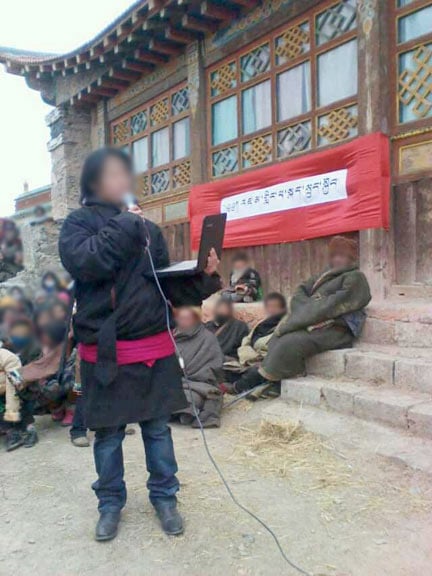
In Chigdril, Amdo, a portrait of the Dalai Lama is flanked by signs which wish for an auspicious International Mother Language Day. Public displays of images the Dalai Lama are typically not allowed by Chinese authorities, but Tibetans gathered nonetheless on February 21, 2013, to hear young students and writers wearing traditional Tibetan clothing recite poems and sing.

